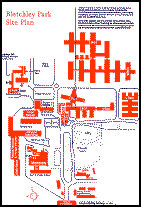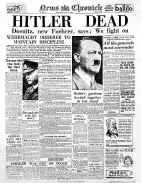|
:: [ The Enigma of
Bletchley Park - SVVS Museum Visit - April 2002 ] ::
The
following text is based on the SVVS Magazine report by Chris Cuss and
the photos are by Bozi Mohacek. Please click on any thumbnail picture below to
see the full size picture. To return to the thumbnails please click the Explorer
"Back" arrow (top left of screen). Pictures have been prepared for
speed of loading,
and the page has been sized to be viewed on an 800 x 600 setup.



On Sunday 14th April, rather than having a lunchtime
pub meeting, we journeyed to the brave new world of Milton Keynes. Not
to see the famous concrete cows but to visit Bletchley Park the wartime
home of Station X and the team who decoded the Nazi's wireless messages.
As some of our proper cars may have found the journey too arduous we all
met at Merstham station and then travelled by coach. One or two members
who were late in booking had to travel in their modern vehicles as such
was the demand for the coach that seating was on first come first served
basis. 



On arrival our group made straight for the Naafi for a tea
and a wad before joining a guided tour gathering in the library. Here
two of the volunteer guides told us some of the background story before
leading us for a tour of the grounds that took about an hour. We were
then free to visit the many rooms in the two huts that remain open to
the public. We were advised that Bletchley Park was built in the 19th
century by a wealthy Jewish businessman as a country retreat. He
insisted that the house incorporated many of the architectural features
that he had seen on his travels across the world. Hence the style is
eclectic to say the least.


 
By the 1930's the house was vacant and with war looming the government
wanted to relocate its cipher and code-breaking department away from the
metropolis. Bletchley was chosen as it was on the main routes from
London to the Midlands, the A5 and the LMS mainline. Conveniently it was
also midway between Oxford and Cambridge it being realised that the
mathematical and analytical brains of these universities would have to
play their part when hostilities commenced. Ultimately some 12,000
people, mainly women, worked in the grounds of the park in hutted
accommodation. At first the huts were wooden but later sturdy blast
resistant buildings were erected. Other than a few support staff
everyone lived in the surrounding countryside. Nearby Woburn Abbey was
home to the many Wrens employed as cipher clerks.


 
The story of how the boffins succeeded in cracking the Enigma code used
by Hitler's armed forces is well known so will not be repeated here.
Suffice to say that it has been estimated that the war in Europe would
have lasted at least another two years without this country's insight
into its enemies' messages. The first atom bomb may well have first
exploded over Berlin rather than Hiroshima. As a direct result of the
machines developed at Bletchley we have the computers that have changed
the way we work for ever. Mick Jagger of the Rolling Stones has
recently financed a film based on the Enigma story and had had four
decrypting machines reconstructed which were on display. In another room
the Colussus, the grandfather of all computers, was being recreated.




Naturally many of the rooms had exhibits relating to the wartime work of
Station X but numerous other groups or societies also had space in the
hut complex. Organisations and displays were as diverse as the Pegasus
Bridge society, the local model boat society, the model railway society,
a collection of Churchill memorabilia, cinema artefacts, even a post-war
Riley could be unearthed as we pottered around. Near the main entrance
there was also an interesting military vehicles section which included a
Chieftain Tank, some concourse standard armoured scout cars and staff
cars, including a batch of army motorcycles. Near the cipher exhibition
was the conning tower section of a German U boat complete with
anti-aircraft guns and machineguns.
 


After the war the codebreakers who were not demobbed moved to Cheltenham
to the building now known as GCHQ. Bletchley Park became a teacher
training college, a GPO training college and finally an air traffic
control training centre. Finally in 1991 the site was empty and ripe for
redevelopment as part of the expanding town of Milton Keynes. Before the
site was flattened the local archaeological society decided to hold a
farewell gathering and invited as many former workers as it could find.
Over 400 turned up and as a result it was decided that the site was too
important to be allowed to disappear. With the help of the local
authority preservation orders were placed on both the buildings and the
trees making it impossible for a developer to clear the plot. A
charitable trust was set up to preserve and maintain the historical
aspects of the park and to allow the public to see where so much vital
work took place during the war years.




Perhaps the most intriguing display was in a building by the main
entrance. Here was retold the on-going mystery of the stolen Abwehr
enigma machine. This was the one that was stolen from its display
cabinet on 1st April a couple of years ago. After some months it was
returned to the TV presenter Jeremy Paxman but lacking its vital three
rotors. A ransom was demanded for these and payment agreed. At the
handover the police swooped and made an arrest. However the police are
certain that the man arrested was not the thief but merely a pawn in
some much deeper plot. They believe that the theft was an inside job and
the perpetrator is still very much at large. Add to this the fact that
the chief executive of the Trust has received hate-mail and even death
threats and we realise that the place still has its share of mystery and
intrigue. All in all a most successful new venture for our society. We
thank the organisers and we look forward to next year's outing.

  

|